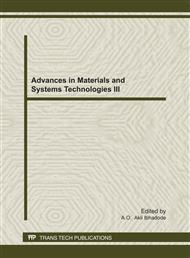[1]
D. G Russell and M. Prats. Practical Aspects of Interlayer Crossflow, J. Pet. Tech, (1962) 589 - 594.
DOI: 10.2118/369-pa
Google Scholar
[2]
M. L Katz, and M. R Tek, A Theoretical study of Pressure Distribution and Fluid flux in Bounded Stratified Porous Systems with crossflow, Soc. Pet. Eng. J. (1970) 503 -511.
DOI: 10.2118/146-pa
Google Scholar
[3]
H.C. Lefkovits, P. Hazebroek, E. E Allen, and C.S. Matthew, A Study of the Behavior of Bounded Reservoirs Composed of Stratified Layers, Soc. Pet. Eng. J. (1961) 43 - 58.
DOI: 10.2118/1329-g
Google Scholar
[4]
J.D. Pendergrass, and V.J. Berry. Pressure Transient Performance of a Multilayered Reservoir with crossflow. Soc. Pet E.J. Dec. (1962) 347 - 354.
DOI: 10.2118/285-pa
Google Scholar
[5]
W.M. Cobb, H.J. Ramey, Jr., and F.G. Miller, Well Test Analysis for wells Producing Commingled Zone. J. Pet. Tech. Jan. (1972), 27 - 37.
DOI: 10.2118/3014-pa
Google Scholar
[6]
R. Raghavan, R Prijambodo and A.C. Reynolds, Well Test Analysis for Wells Producing Layered Reservoir with Crossflow, Soc. Pet. Eng. J. (1985) 407 -418.
DOI: 10.2118/10262-pa
Google Scholar
[7]
D. Bourdet, Pressure Behavior of Layered Reservoir with Crossflow, SPE paper No. 13628, presented at the 55 th Annual California Regional Meeting in Bakersfield C.A. Mar. 27 - 29 (1985).
DOI: 10.2118/13628-ms
Google Scholar
[8]
L. Larsen, Determination of Skin Factors and Flow Capacities of Individual Layers in TwoLayered Reservoir, SPE paper No 11138, presented at the 57 th Annual Technical Conference and Exhibition in New Orleans L.A., Sep. 26 - 29 (1982).
Google Scholar
[9]
P. A Goode and R.K. M Thambynayagam, Pressure Drawdown and Buildup Analysis of Horizontal wells in Anisotropic Media. SPEFE Trans., AIME, 283 (1987) 683 -97.
DOI: 10.2118/14250-pa
Google Scholar
[10]
F. J Kuchuk,.: 'Well Testing and Interpretation for Horizontal Wells, ', JPT(January 1995) 36.
Google Scholar
[40]
[11] J.B. Spath, E. Ozkan, and R. Raghavan, An Efficient Algorithm for Computation of Well Responses in Commingled Reservoir, SPEFE (1994)115 - 121.
DOI: 10.2118/21550-pa
Google Scholar
[12]
F.J. Kuchuk. Pressure Behavior of Laterally Composite Reservoirs, SPE 24678 presented at the 67th SPE Annual Technical Conference and Exhibition, Washington, DC (1992).
Google Scholar
[13]
E. S Adewole. Theoretical Dimensionless Breakthrough Time of a Horizontal Well in a TwoLayered Reservoir System with Varying Architecture Part I: Letter B, -Architecture, Edge Water Drive Mechanism. ICERD 10018, (2010).
DOI: 10.4028/www.scientific.net/amr.367.375
Google Scholar
[14]
A.C. Gringarten and H.J. Ramey, Jr. The Use of Source and Green's Functions in Solving Unsteady-Flow Problems in Reservoirs SPE Trans.; AIME, (1973) 255-285.
DOI: 10.2118/3818-pa
Google Scholar
[15]
E. S Adewole,. Instantaneous Source Functions for Selected Layered Reservoir Systems with Crossflow: Part I: Horizontal Wells and Constant-Pressure Boundaries, Journal of Engineering for Development 7 (2007).
Google Scholar
[1]
vi(z) vi(z) N. A.
Google Scholar
[2]
iv(z) vi(z) v(z).
Google Scholar
[3]
x(x). vi(z) vi(z) x(x).
Google Scholar
[4]
viii(x). iv(z) vi(z) viii(x). v(z) 5. viii(x). vi(z) viii(x). vi(z) ix(x).
Google Scholar
[6]
viii(x). vi(z) viii(x). vi(z) x(x).
Google Scholar
[7]
viii(x). iv(z) viii(x). vi(z) v(z).
Google Scholar
[8]
ix(x). iv(z) ix(x). vi(z) v(z).
Google Scholar
[9]
ix(x). iv(z) vi(z) ix(x). v(z).
Google Scholar
[10]
x(x). iv(z) x(x). vi(z) v(z).
Google Scholar
[11]
x(x). iv(z) vi(z) x(x). v(z).
Google Scholar
[12]
` viii(x). vi(z) x(x). vi(z) x(x).
Google Scholar
[13]
viii(x). vi(z) ix(x). vi(z) x(x).
Google Scholar
[14]
x(x). vi(z) x(x). vi(z) x(x).
Google Scholar
[15]
ix(x). vi(z) ix(x). vi(z) ix(x).
Google Scholar
[16]
viii(x). vi(z) viii(x). vi(z) N. A.
Google Scholar
[17]
viii(x). vi(z) vi(z) viii(x).
Google Scholar
[18]
viii(x). iv(z) viii(x). vi(z) viii(x). v(z).
Google Scholar
[19]
viii(x). iv(z) viii(x). vi(z) x(x). v(z).
Google Scholar
[20]
viii(x). iv(z) ix(x). vi(z) viii(x). v(z).
Google Scholar
[21]
viii(x). iv(z) viii(x). vi(z) ix(x). v(z) 22. viii(x). iv(z) x(x). vi(z) viii(x). v(z).
Google Scholar
[23]
viii(x). vi(z) viii(x). vi(z) viii(x).
Google Scholar
[24]
x(x). iv(z) x(x). vi(z) x(x). v(z).
Google Scholar
[25]
ix(x). iv(z) ix(x). vi(z) ix(x). v(z).
Google Scholar
[26]
viii(x). iv(z) ix(x). vi(z) x(x). v(z).
Google Scholar
[27]
viii(x). iv(z) x(x). vi(z) ix(x). v(z).
Google Scholar
[28]
viii(x). vi(z) ix(x). vi(z) viii(x).
Google Scholar


